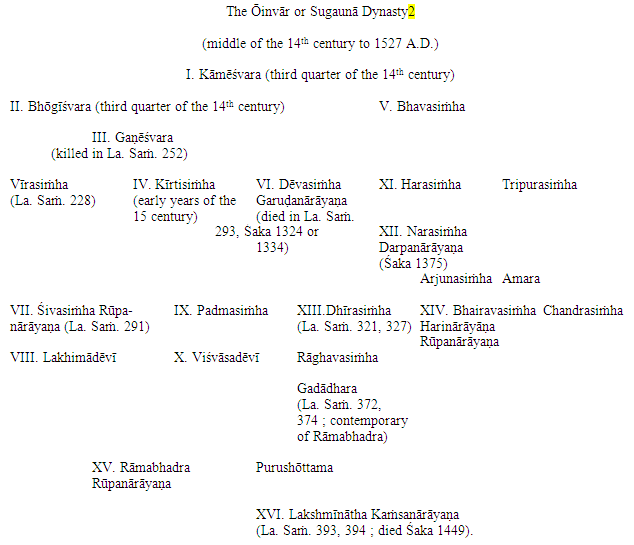|
EPIGRAPHIA INDICA
Śaka 1449 (1527 A.D.), although according to a tradition followed by Eggeling he was ruling in
1532 A.D. and according to another followed by Grierson in 1542 A.D.[1]

__________________________________________________________
[1] Eggeling, loc. cit.; Grierson, Introduction to Maithilī Language, Part II, p. 96 ; Thakur, op. cit., p. 339 and
note 2.
[2]
The genealogy quoted by Grierson (Ind. Ant. Vol. XIV., p. 196) represents Kāmēśvara as the son of
Lakshmaṇa, grandson of Gōvinda, great-grandson of Viśvarūpa and great-great-grandson of Atirūpa. Udayasiṁha is mentioned as another son of Bhavasiṁha and Sarvasiṁha is represented as the only son of Tripurasiṁha.
Ratnēśvarasiṁha (Raṭāya), Raghusiṁha Vijayanārāyaṇa and Brahmasiṁha Harinārāyaṇa are mentioned as
brothers of Narasiṁha Darpanārāyaṇa. A brother of Chandrasiṁha was Durlabhasiṁha or Raṇasiṁha whose son was Viśvanātha Naranārāyaṇa, Rāmachandra and Pratāparudra are represented as the sons of Viśvanātha,
and Ratnasiṁha as the son of Rāmachandra. Purushōttama seems to be mentioned as Garuḍanārāyaṇa A
brother of Lakshmīnātha Kaṁsanārāyaṇa was Balabhadra and his two step-brothers were Ratinātha and Bhavanātha Hṛidayanārāyaṇa. Mention is also made of Dhīrasiṁha’s son Jaganunārāyaṇa whose sons were Madhusūdana, Śrīnātha, Kīrtisiṁha, Rudranārāyaṇa and Vīravara.
|